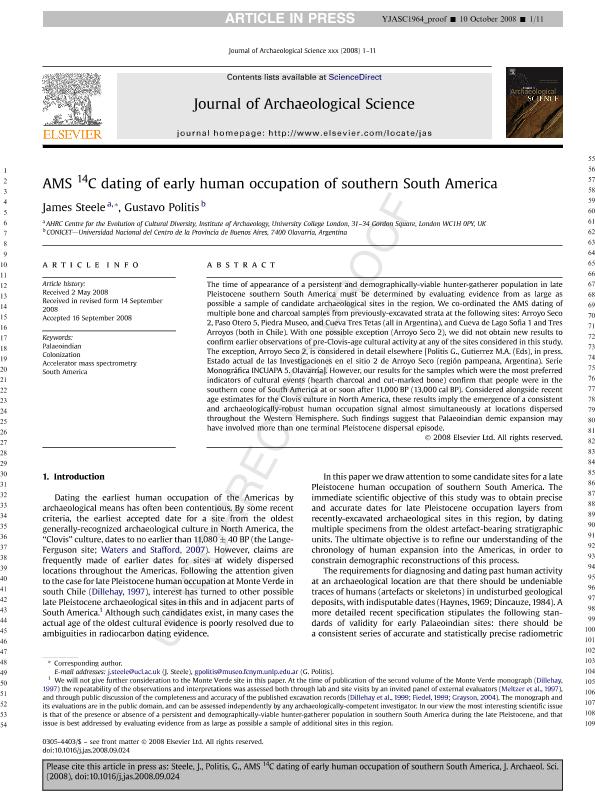Artículo
AMS 14C dating of early human occupation of southern South America
Fecha de publicación:
12/2008
Editorial:
Academic Press Ltd - Elsevier Science Ltd
Revista:
Journal of Archaeological Science
ISSN:
0305-4403
Idioma:
Inglés
Tipo de recurso:
Artículo publicado
Clasificación temática:
Resumen
The time of appearance of a persistent and demographically-viable hunter-gatherer population in late Pleistocene southern South America must be determined by evaluating evidence from as large as possible a sample of candidate archaeological sites in the region. We co-ordinated the AMS dating of multiple bone and charcoal samples from previously-excavated strata at the following sites: Arroyo Seco 2, Paso Otero 5, Piedra Museo, and Cueva Tres Tetas (all in Argentina), and Cueva del Lago Sofia 1 and Tres Arroyos (both in Chile). With one possible exception, we did not obtain new results to confirm earlier observations of pre-Clovis-age cultural activity at any of the sites considered in this study. The possible exception, Arroyo Seco 2, is considered in detail elsewhere [Politis G., Gutierrez M.A., Scabuzzo, C. (Eds), in press. Estado actual de las Investigaciones en el sitio 2 de Arroyo Seco (región pampeana, Argentina). Serie Monográfica INCUAPA 5. Olavarría]. However, our results for the samples which were the most preferred indicators of cultural events (hearth charcoal and cut-marked bone) confirm that people were in the southern cone of South America at or soon after 11,000 BP (13,000 cal BP). Considered alongside recent age estimates for the Clovis culture in North America, these results imply the contemporaneous emergence of a consistent and archaeologically-robust human occupation signal at widely-separated locations across the Western Hemisphere. Such findings suggest that Palaeoindian demic expansion may have involved more than one terminal Pleistocene dispersal episode.
Palabras clave:
ACCELERATOR MASS SPECTROMETRY
,
COLONIZATION
,
PALAEOINDIAN
,
SOUTH AMERICA
Archivos asociados
Licencia
Identificadores
Colecciones
Articulos(INCUAPA)
Articulos de INVESTIGACIONES ARQUEOLOGICAS Y PALEONTOLOGICAS DEL CUATERNARIO PAMPEANO
Articulos de INVESTIGACIONES ARQUEOLOGICAS Y PALEONTOLOGICAS DEL CUATERNARIO PAMPEANO
Citación
Steele, James; Politis, Gustavo Gabriel; AMS 14C dating of early human occupation of southern South America; Academic Press Ltd - Elsevier Science Ltd; Journal of Archaeological Science; 36; 2; 12-2008; 419-429
Compartir
Altmétricas




